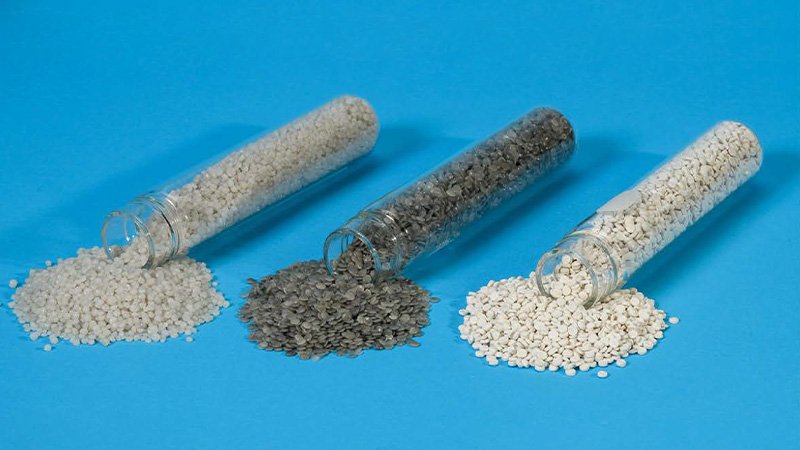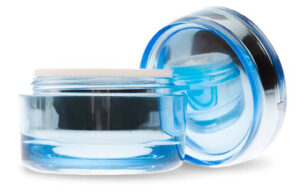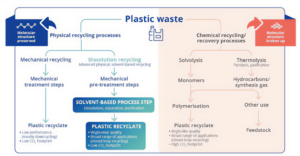Recycling 2.0: No Longer the Industry of Yore

Developments in technology increase reuse processes and the quality of recyclate
Plastics are hogging the limelight these days, for better or worse. From National Public Radio to The Atlantic to the Financial Times to local town councils, everyone is talking about it: ban it, burn it, bury it, recycle it, stop using it altogether. At the same time as cities and states are debating what to do with straws and bags, the private sector is raising and spending massive amounts on new plastics recycling technologies that range from improved mechanical systems (simplified as clean/grind/re-melt) to novel advanced techniques that include both physical and chemical processes to purify or recreate polymer-based materials.
As with many topics, the debate over plastics and circularity splits opinions. But as with any complex subject that straddles multiple disciplines, there is a lot of grey area and not a lot of simple solutions. It’s a bit like looking through a kaleidoscope: a turn of the lens will change how we see things, if not exactly changing what we see. What follows is an attempt to clarify some of the terminology related to recent developments in advanced recycling.
Before exploring the advanced topics, however, one should point out that mechanical recycling today is not your father’s recycling. Improvements in technology have led to higher-quality post-consumer recycled (PCR) content, which in turn is leading to a greater acceptance of it in food-contact applications. Revolution Co. of Little Rock, Ark., recently announced that it had received a Letter of No Objection from the U.S. Food and Drug Administration for its linear low-density polyethylene materials which are mechanically recycled with a certified chain of custody and wash process.
The emergence of several startup companies and new ventures, backed by serious private equity capital, should send a strong signal that mechanical recycling is in no danger of being supplanted. Groups like Ara Partners have invested in plastics recycling via Circulus of Houston, whose focus is on PE, and Aloxe in France and the Netherlands, which focuses on polyethylene terephthalate (PET). Aloxe is only now emerging from “stealth mode,” but Circulus has entered into a long-term agreement to supply Nova Chemicals with recycled PE. (To read an interview with Greg DeKunder, vice president of marketing for PE at Nova, about the resin maker’s work with circularity, see October 2021 Plastics Engineering, p. 32.) Circulus raised $100 million in debt financing in December 2021.
Meanwhile, UBQ of Israel recently raised $170 million in venture funding. UBQ is structured as a Certified B Corporation, a designation that commits the company to formalizing its environmental principles alongside its fiduciary ones. Unlike other recycling firms, however, UBQ claims to provide a carbon-negative material derived from residual solid waste previously considered unrecyclable.
Over the course of the past decade—and rapidly so during the past 5 years, in fact—several high-profile developments in advanced recycling have piqued the interest of the plastics industry, university tech transfer offices and the public. As with any new, fast-moving, dynamic market, one can only provide a snapshot at a given point in time, synthesizing and summarizing the current literature, and offering some guarded prognostications for the future. This is neither comprehensive nor exhaustive since events are moving rapidly and simultaneously in North America, Europe and Asia.
Advanced Physical Recycling
Most people are familiar with mechanical recycling, a physical process whereby the composition of a polymer remains unchanged. Solvent-based purification, or dissolution, is also a physical process, though it has sometimes been categorized incorrectly as chemical recycling. This type of advanced recycling is currently being done at scale in Germany and was selected by Unilever to recycle olefins from landfilled post-consumer multilayer film packaging in Indonesia. This pilot project, however, was ultimately deemed unsuccessful due to economic challenges with input costs (payments to waste pickers), a larger than expected presence of aluminum in multilayer sachets and lower than expected yields in the recycling process due in large part to the lower fraction of olefins. Yet because the dissolution technology works effectively with polymers of the same type, and can separate embedded additives or impurities, it has led to other pilot projects in Europe, including separation of multilayer waste (PE/polyamide or polypropylene/PET) and expandable polystyrene/extruded PS from legislated flame-retardant HBCD (hexabromocyclododecane).

Laundry detergent and other high-volume packaging are important sources of recyclate as well as applications for PCR resins. Courtesy of Nova Chemicals
Delamination of multilayer film is a low-energy mechanical recycling process in which films are first shredded, then broken down further via surfactant-based micro-emulsions. A Germany-based company, Saperatec, has been operating since 2014 and works with mixed formats such as PE/aluminum, PP/aluminum or PE/PET.
Selective extraction processes are another class of advanced physical or mechanical recycling where dissolution is applied to separate and extract polymers. This is sometimes incorrectly referred to as solvolysis. Companies such as APK AG, Merseburg, Germany, and CreaCycle GmbH, Grevenbroich, Germany, have developed customized solvent formulations that selectively dissolve the desired polymers so they can be recovered and reprecipitated and/or repelletized. The solvents themselves are recycled and the purified polymer recyclates display properties similar to virgin polymers.
In North America, Procter & Gamble spun off a technology summarized as a high-pressure, supercritical extraction and filtration process for recycling PP. PureCycle Technologies, the company which went public via a specialpurpose acquisition company in May 2020, has developed a series of off-take agreements for “ultra-pure polypropylene” that reportedly exhibits properties identical to virgin PP. As a major user of PP in its consumer product portfolio, P&G has sent a strong signal to investors, technologists and regulators that demand for recycled materials can be created and satisfied. It is also proof that elegant and profitable business models can be combined with cutting-edge polymer science.
Unzipping Polymers
Breaking polymers down—or “unzipping” them—into monomers so that they can be repolymerized is the essence of chemical recycling. Sometimes referred to as molecular recycling, and sometimes classified as a decomposition method, depolymerization of PET, for example, results in separation of its component parts monoethylene glycol and dimethyl terephthalate. In the case of PS, the depolymerization of the polymer to the styrene monomer has been shown to reduce greenhouse gas (GHG) emissions by 50 percent when compared to virgin, petrochemical-based styrene.

Some producers add PCR to virgin resins for high-end goods like cosmetics jars. Eastman’s
Cristal 400 Renew is a high-flow PETG grade with 30 or 50 percent loadings of recycled
content and the potential for all-PCR versions. Courtesy of Eastman
As mentioned, several companies including Ioniqa of the Netherlands, Carbios of France and Loop Industries of Canada have taken significant steps toward commercialization, though not without difficulty or controversy. In 2020, Hindenburg Research, a forensic financial research firm, published a scathing report suggesting that Loop’s claims were false and that their technology was not viable. Hindenburg went on to take a short position against Loop which led to a sharp drop in its listed stock price. Yet because the demand for PCR PET continues to increase, thanks in no small part to highly visible public commitments from consumer product goods brands, interest in Loop’s technology remains high. Recent transcripts from the company’s earnings call indicate that growth and scale is dependent on government subsidies for new proposed factories in Canada, France and South Korea.
In a significant commitment to the depolymerization approach, industry heavyweight Eastman recently announced a $1 billion project in France to commercialize its polyester renewal technology. This follows a $250 million project at U.S. headquarters in Kingsport, Tenn. The company is switching from glycolysis to methanolysis for feedstock treatment, primarily because glycolysis requires a cleaner stream of recyclable materials, which limits inputs and, presumably, related economics. Considered a moonshot by some observers, Eastman has recently divested some noncore businesses in order to continue funding circular economy targets. The company projects annual capacity of 160,000 metric tons in France and 100,000 metric tons in Kingsport, certainly not pilot scale, to say the least.
Though they differ in terms of polymers/monomers used, these business models share an important attribute: securing off-take agreements—i.e., purchasing contracts. This demand-side security ensures continued investment so that product can be manufactured and sold on a contractual basis. In November 2021, Berry Global announced a major off-take agreement with PureCycle to ensure up to 600 million pounds of purified PP per year starting in 2025.

Some companies use selective extraction processes in recycling. APK is among those with solvent formulations that selectively dissolve desired polymers for recovery (shown at left in diagram). The purified polymer recyclates display properties similar to virgin polymers. Courtesy of APK AG
Gasification and Pyrolysis
Not to be confused with incineration, gasification or pyrolysis typically exhibit low GHG emissions, do not produce dioxins and yield useful chemicals that can be converted back into new materials. And though some are quick to point out that these processes are not closed loop in the way that depolymerization is, it is important to recognize that anaerobic thermal gasification or plasma pyrolysis of waste materials can displace virgin components when producing chemicals or fuels. In other words, just because petrochemical-based polymeric materials are being converted into other petrochemical-based materials, it doesn’t mean that environmental benefits cannot be identified and acknowledged.
There are many pilot projects around the world where mixed plastics and waste chemicals are being converted to base fuels, gases and waxes. Fluidized-bed gasification, for example, is where carbon-rich waste feedstocks are first converted into synthetic gas (syngas), then through further catalytic conversion and purification, refined into ultra-clean biofuels (methanol, ethanol) and chemicals. This process, mastered by Enerkem of Montreal, replaces the use of fossil sources, avoids incineration-related emissions and, when compared to landfilling, reuses carbon that would ultimately be lost or buried. Agilyx of Tigard, Ore., has spent the past 15 years developing 30 types of pyrolysis, or thermo-chemical processes, to create fuels and synthetic oils for multiple industries, including aviation. What began as a method of turning PS back into styrene monomer for refinement has evolved into a highly sophisticated data analytics and predictive modeling company that has created its own syndicated supply chain system. Agilyx has signed a joint development agreement with chemical giant Ineos and recently completed a private placement on the Merkur Market in Norway. And Eastman is moving to scale up its carbon renewal technology, which reportedly delivers syngas with 20 to 50 percent less GHG emissions than comparable virgin-based inputs.
End-of-life options for low-value or mixed plastics are extremely limited (“bury or burn”) and there is no one-size-fits-all solution. Tight regulation of landfill space in Europe, for example, leads to higher acceptance of incineration. In the U.S., the opposite is true: an abundance of land, relatively cheap fuel and low tipping fees mean that landfilling waste materials is the path of least resistance in terms of end-of-life management.
It seems that an all-of-the-above approach will remain viable for the short term until one or more technologies or, perhaps more importantly, business models, emerge as clear winners. Given the scale of the challenge, however, and the variety of environments around the world (ecological, legislative, financial), one can easily venture that the results won’t be uniform.
Conor Carlin is SPE’s vice president of sustainability, the first to hold that position. A member since 2000, he was elected to the Executive Board in 2017 and again in 2020. Carlin serves as editor for SPE Thermoforming and Recycling Division publications and has written articles on plastics and sustainability for the industry press in the U.S., Europe and Asia. He is co-author and editor of the 2nd edition of “Plastics & Sustainability: Grey Is the New Green,” published by Scrivener/Wiley. He is also managing director of Illig NA, a subsidiary of Illig Maschinenbau, Germany-based manufacturer of thermoforming, tooling and packaging systems. Carlin has undergraduate degrees from Boston University and an MBA from the FW Olin Graduate School of Business at Babson College.
